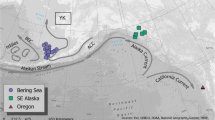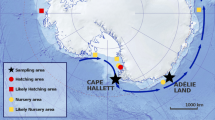Abstract
The composition of the opaque and translucent bands in the otoliths of European hake (Merluccius merluccius) from three different populations (Celtic Sea, Galicia shelf and Cretan Sea) was analysed with wavelength dispersive spectrometry (WDS) and differences in Ca, Sr and Na were compared. The translucent bands (annual marks and checks altogether) were significantly richer in Sr and Ca and significantly poorer in Na than opaque bands. Results support the idea of a more compact arrangement of crystals in translucent bands compared to opaque. Analyses did not help to discriminate between putative annual marks and checks. Clear differences in the range of Sr/Ca variation across the otolith as well as in the composition of the otolith core were observed among the three populations. As a result it was possible to discriminate the natal origin of each fish using the composition of the otolith core in Ca, Sr and Na. Nevertheless, the overall pattern across the otolith was similar among the three populations suggesting the existence of ontogenetic trends. Variation of Na/Ca ratios was largely uninformative. Based on these results, a conceptual model for hake is proposed which integrates the different sources of otolith Sr/Ca variation: ambient Sr/Ca, endogenous cues (ontogeny) and exogenous cues (environment).









Similar content being viewed by others
References
Arai T, Otake T, Tsukamoto K (1997) Drastic changes in otolith microstructure and microchemistry accompanying the onset of metamorphosis in the Japanese eel Anguilla japonica. Mar Ecol Prog Ser 161:17–22
Bernat M, Church T, Allegre CJ (1972) Barium and strontium concentrations in Pacific and Mediterranean sea water profiles by direct isotope dilution mass spectrometry. Earth Planet Sci Lett 16:75–80
Bozzano A, Catalán I (2002) Ontogenetic changes in the retinal topography of the European hake, Merluccius merluccius: implications for feeding and depth distribution. Mar Biol 141:549–559
Bozzano A, Recasens L, Sartor P (1997) Diet of the European hake Merluccius merluccius (Pisces: Merluciidae) in the western Mediterranean (Gulf of Lions). Sci Mar 61:1–8
Brass GW, Turekian KK (1972) Strontium distributions in sea water profiles from the Geosecs I (Pacific) and Geosecs II (Atlantic) test stations. Earth Planet Sci Lett 16:117–121
Campana SE (1999) Chemistry and composition of fish otoliths: pathways, mechanisms and applications. Mar Ecol Prog Ser 188:263–297
Curti E (1999) Coprecipitation of radionuclides with calcite: estimation of partition coefficients based on a review of laboratory investigations and geochemical data. Appl Geochem 14:433–445
De Pontual H, Lagardère F, Amara R, Bohn M, Ogor A (2003) Influence of ontogenetic and environmental changes in the otolith microchemistry of juvenile sole (Solea solea). J Sea Res 50:199–211
De Villiers S (1999) Seawater strontium and Sr/Ca variability in the Atlantic and Pacific oceans. Earth Planet Sci Lett 171:623–634
Fowler AJ, Campana SE, Jones CM, Thorrold SR (1995) Experimental assessment of the effect of temperature and salinity on elemental composition of otoliths using laser ablation ICPMS. Can J Fish Aquat Sci 52:1431–1441
Fuiman LA, Hoff GR (1995) Natural variation in elemental composition of sagittae from red drum. J Fish Biol 47:940–955
Gauldie RW (1999) Ultrastructure of lamellae, mineral and matrix components of fish otolith twinned aragonite crystals: implications for estimating age in fish. Tissue Cell 31:138–153
Gauldie RW, Thacker CE, West IF, Wang L (1998) Movement of water in fish otoliths. Comp Biochem Physiol 120A:551–556
Guichet R (1995) The diet of European hake (Merluccius merluccius) in the northern part of the Bay of Biscay. ICES J Mar Sci 52:21–31
Kalish JM (1991) Determinants of otolith chemistry: seasonal variation in the composition of blood plasma, endolymph and otoliths of bearded rock cod Pseudophycis barbatus. Mar Ecol Prog Ser 74:137–159
Lombarte A, Popper AN (2004) Quantitative changes in the otolithic organs of the inner ear during the settlement period in European hake Merluccius merluccius. Mar Ecol Prog Ser 267:233–240
Lombarte A, Torres GJ, Morales-Nin B (2003) Specific Merluccius otolith growth patterns related to phylogenetics and environmental factors. J Mar Biol Assoc UK 83:277–281
Milton DA, Chenery SR (1998) The effect of otolith storage methods on the concentrations of elements detected by laser-ablation ICPMS. J Fish Biol 53:785–794
Morales-Nin B, Aldebert Y (1997) Growth of juvenile Merluccius merluccius in the Gulf of Lions (NW Mediterranean) based on otolith microstructure and length-frequency analysis. Fish Res 30:77–85
Morales-Nin B, Torres GJ, Lombarte A, Recasens L (1998) Otolith growth and age estimation in the European hake. J Fish Biol 53:1155–1168
Olaso I (1993) Posición trófica de la merluza en la plataforma cantábrica. In: González-Garcés Santiso A, Pereiro Muñoz FJ (eds) Working group on the present state of knowledge of hake populations which live on the continental shelf on the Atlantic and Mediterranean parts of the European Union, with special attention to the Iberian peninsula. Centro Oceanográfico de Vigo (IEO) and The European Community Programme Air, Vigo, Spain, pp 193–206
Palacios R, Orensanz JM, Armstrong DA (1994) Seasonal and life-long variation of Sr/Ca ratio in shells of Mya arenaria from Grays harbor (Washington)—an ancillary criterion in demographic studies. Estuar Coast Shelf Sci 39:313–327
Pereiro FJ, Fernández A (1983) Relación entre las edades y la profundidad, e índices y áreas de reclutamiento de la merluza, en Galicia y aguas adyacentes. Bol Inst Esp Oceanogr 1:45–54
Piñeiro C, Saínza M (2003) Age estimation, growth and maturity of the European hake (Merluccius merluccius (Linnaeus, 1758)) from Iberian Atlantic waters. ICES J Mar Sci 60:1086–1102
Proctor CH, Thresher RE (1998) Effects of specimen handling and otolith preparation on concentration of elements in fish otoliths. Mar Biol 131:681–694
Recasens L (1993) La merluza del Mediterráneo. La comunidad de que forma parte. Aspectos biológicos de la especie: alimentación, ciclo vital y reproducción. Explotación: pesquería. In: González-Garcés Santiso A, Pereiro Muñoz FJ (eds) Working group on the present state of knowledge of hake populations which live on the continental shelf on the Atlantic and Mediterranean parts of the European Union, with special attention to the Iberian peninsula. Centro Oceanográfico de Vigo (IEO) and The European Community Programme Air, Vigo, Spain, pp 237–254
Recasens L, Lombarte A, Morales-Nin B, Torres GJ (1998) Spatiotemporal variation in the population structure of the European hake in the NW Mediterranean. J Fish Biol 53:387–401
Sánchez F (1993) Patrones de distribución y abundancia de la merluza en aguas de la plataforma norte de la Península Ibérica. In: González-Garcés Santiso A, Pereiro Muñoz FJ (eds) Working group on the present state of knowledge of hake populations which live on the continental shelf on the Atlantic and Mediterranean parts of the European Union, with special attention to the Iberian peninsula. Centro Oceanográfico de Vigo (IEO) and The European Community Programme Air, Vigo, Spain, pp 255–280
Seyama H, Edmonds JS, Moran MJ, Shibata Y, Soma M, Morita M (1991) Periodicity in fish otolith Sr, Na, and K corresponds with visual banding. Experientia 47:1193–1196
Sobrino I, Jiménez MP, Ramos F (1993) Resultados preliminares sobre la distribución y abundancia de la merluza europea (Merluccius merluccius L.) en la región suratlántica española. In: González-Garcés Santiso A, Pereiro Muñoz FJ (eds) Working group on the present state of knowledge of hake populations which live on the continental shelf on the Atlantic and Mediterranean parts of the European Union, with special attention to the Iberian peninsula. Centro Oceanográfico de Vigo (IEO) and The European Community Programme Air, Vigo, Spain, pp 281–304
Thorrold SR, Shuttleworth S (2000) In situ analysis of trace elements and isotope ratios in fish otoliths using laser ablation sector field inductively coupled plasma mass spectrometry. Can J Fish Aquat Sci 57:1232–1242
Thresher RE, Proctor CH, Gunn JS, Harrowfield IR (1994) An evaluation of electron-probe microanalysis of otoliths for stock delineation and identification of nursery areas in a southern temperate groundfish, Nemadactylus macropterus (Cheilodactylidae). Fish Bull 92:817–840
Tomás J, Geffen AJ (2003) Morphometry and composition of aragonite and vaterite otoliths of deformed laboratory reared juvenile herring from two populations. J Fish Biol 63:1383–1401
Toole CL, Markle DF, Harris PM (1993) Relationships between otolith microstructure, microchemistry, and early life history events in Dover sole, Microstomus pacificus. Fish Bull 91:732–753
Troadec H (1992) Reconnaissance de structures sur des pièces calcifiées par imagerie numérique dans le but de suivi d’un stock halieutique. Université de Paris VII
Tzeng WN, Severin KP, Wickström H, Wang CH (1999) Strontium bands in relation to age marks in otoliths of European eel Anguilla anguilla. Zool Stud 38:452–457
Velasco F, Olaso I (1998) European hake Merluccius merluccius (L., 1758) feeding in the Cantabrian Sea: seasonal, bathymetric and length variations. Fish Res 38:33–44
Wasserman RH (1998) Strontium as a tracer for calcium in biological and clinical research. Clin Chem 44:437–439
Wright PJ, Panfili J, Morales-Nin B, Geffen AJ (2002) Types of calcified structures. In: Panfili J, De Pontual H, Troadec H, Wright PJ (eds) Manual of fish sclerochronology. Ifremer-IRD coedition, Brest, France, pp 31–87
Acknowledgements
We are indebted to Dr Pete Hill from the Faculty of Geology and Geophysics of the University of Edinburgh (UK) for WDS analyses. This study was funded by the European Union, Project DG-XIV-96-075 and NERC (National Environment Research Council, UK) through funding of the WDS analyses.
Author information
Authors and Affiliations
Corresponding author
Additional information
Communicated by J.P. Thorpe, Port Erin
Rights and permissions
About this article
Cite this article
Tomás, J., Geffen, A.J., Millner, R.S. et al. Elemental composition of otolith growth marks in three geographically separated populations of European hake (Merluccius merluccius). Marine Biology 148, 1399–1413 (2006). https://doi.org/10.1007/s00227-005-0171-6
Received:
Accepted:
Published:
Issue Date:
DOI: https://doi.org/10.1007/s00227-005-0171-6




